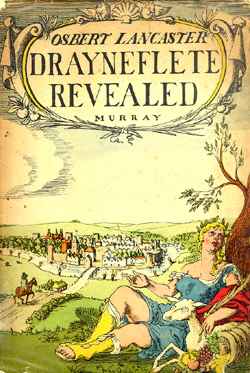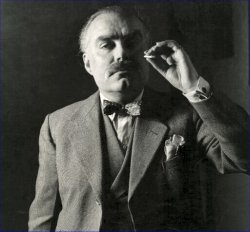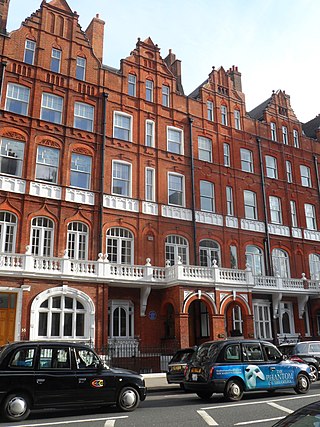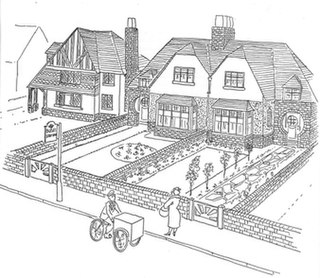
Ben Travers was an English writer. His output includes more than 20 plays, 30 screenplays, 5 novels, and 3 volumes of memoirs. He is most notable for his long-running series of farces first staged in the 1920s and 1930s at the Aldwych Theatre. Many of these were made into films and later television productions.

"Away in a Manger" is a Christmas carol first published in the late nineteenth century and used widely throughout the English-speaking world. In Britain, it is one of the most popular carols; a 1996 Gallup Poll ranked it joint second. Although it was long claimed to be the work of German religious reformer Martin Luther, the carol is now thought to be wholly American in origin. The two most common musical settings are by William J. Kirkpatrick (1895) and James Ramsey Murray (1887).

Osbert Lancaster's Drayneflete Revealed, is an illustrated book on architectural style.
John Cameron Andrieu Bingham Michael Morton, better known by his preferred abbreviation J. B. Morton, was an English humorous writer noted for authoring a column called "By the Way" under the pen name 'Beachcomber' in the Daily Express from 1924 to 1975.

"Home! Sweet Home!" is a song adapted from American actor and dramatist John Howard Payne's 1823 opera Clari, or the Maid of Milan. The song's melody was composed by Englishman Sir Henry Bishop with lyrics by Payne. Bishop had earlier published a more elaborate version of this melody, naming it "A Sicilian Air", but he later confessed to having written it himself.

Sir Osbert Lancaster was an English cartoonist, architectural historian, stage designer and author. He was known for his cartoons in the British press, and for his lifelong work to inform the general public about good buildings and architectural heritage.

John Michael Terence Wellesley Denison was an English actor. He often appeared with his wife, Dulcie Gray, with whom he featured in several films and more than 100 West End theatre productions.

Thomas Kirby Walls was an English stage and film actor, producer and director, best known for presenting and co-starring in the Aldwych farces in the 1920s and for starring in and directing the film adaptations of those plays in the 1930s.

John Robertson Hare, OBE was an English actor, who came to fame in the Aldwych farces. He is remembered by more recent audiences for his performances as the Archdeacon in the popular BBC sitcom, All Gas and Gaiters.

The Olympic Theatre, sometimes known as the Royal Olympic Theatre, was a 19th-century London theatre, opened in 1806 and located at the junction of Drury Lane, Wych Street and Newcastle Street. The theatre specialised in comedies throughout much of its existence. Along with three other Victorian theatres, the Olympic was eventually demolished in 1904 to make way for the development of the Aldwych. Newcastle and Wych streets also vanished.

Pont Street is a fashionable street in the Royal Borough of Kensington and Chelsea, London, traversing the areas of Knightsbridge and Belgravia. The street is not far from the Knightsbridge department store Harrods to its north-west. The street crosses Sloane Street in the middle, with Beauchamp Place to the west and Cadogan Place, and Chesham Place, to the east, eventually leading to Belgrave Square. On the west side, Hans Place leads off the street to the north and Cadogan Square to the south.

Pillar to Post is a book of drawings and text by Osbert Lancaster. It was first published in 1938 and covers the history of western architecture from Ancient Egypt to buildings of the 1930s. There were 40 chapters in the original edition. Lancaster later added two more. Each chapter consists of a page of text on the left and a drawing on the right. The texts vary in length but are typically between 300 and 400 words each.

The Aldwych farces were a series of twelve stage farces presented at the Aldwych Theatre, London, nearly continuously from 1923 to 1933. All but three of them were written by Ben Travers. They incorporate and develop British low comedy styles, combined with clever word-play. The plays were presented by the actor-manager Tom Walls and starred Walls and Ralph Lynn, supported by a regular company that included Robertson Hare, Mary Brough, Winifred Shotter, Ethel Coleridge, and Gordon James.

Pont Street Dutch is a term coined by Osbert Lancaster to describe an architectural style typified by the large red brick gabled houses built in the 1880s in Pont Street and adjacent areas such as Hans Place and Cadogan Gardens in Knightsbridge, London. The description first appeared in Lancaster's Pillar to Post, published in 1938, and was subsequently adopted by other architectural writers. Nikolaus Pevsner writes of the style as "tall, sparingly decorated red brick mansions for very wealthy occupants, in the semi-Dutch, semi-Queen-Anne style of Shaw or George & Peto".

Marchese Piero Luigi Carlo Maria Malacrida de Saint-August was an Italian aristocrat, playboy and London-based interior designer. The Malacrida family were from Lombardy and a Palazzo Malacrida still exists in Morbegno, Lombardy. The property passed to another family in 1820 and is currently in the hands of the municipality.

Osbert Parsley was an English Renaissance composer and chorister. Few details of his life are known, but he evidently married in 1558, and lived for a period in the parish of St Saviour's Church, Norwich. A boy chorister at Norwich Cathedral, Parsley worked there throughout his musical career. He was first mentioned as a lay clerk, was appointed a "singing man" in c. 1534, and was probably the cathedral's unofficial organist for half a century. His career spanned the reigns of Henry VIII and all three of his children. After the Reformation of 1534, the lives of English church musicians changed according to the official policy of each monarch.

Stockbroker's Tudor, sometimes alternatively Stockbrokers Tudor or Stockbroker Tudor, was a term coined by the architectural historian and cartoonist Osbert Lancaster for a style of house that became popular in Britain in the first half of the 20th century, employing pastiche Tudor features on the façades of houses, before and during the development of suburban Metroland.

Curzon Street Baroque is a 20th-century inter-war Baroque revival style. It manifested itself principally as a form of interior design popular in the homes of Britain's wealthy and well-born intellectual elite. Its name was coined by the English cartoonist and author Osbert Lancaster, as Curzon Street in Mayfair was an address popular with London high society. While previous forms of Baroque interior design had relied on French 18th-century furnishings, in this form it was more often than not the heavier and more solid furniture of Italy, Spain, and southern Germany that came to symbolise the furnishings of new fashion.

By-pass Variegated is a term coined by the cartoonist and architectural historian Osbert Lancaster in his 1938 book Pillar to Post. It represents the ribbon development of houses in Britain in the 1920s and 1930s, in a mish-mash of architectural styles.
Aldwych Farcical is a term coined by the artist and author Osbert Lancaster for a style of English interior design fashionable in the 1920s and 1930s. Lancaster devoted a chapter of his 1939 book Homes Sweet Homes to the style, taking the name from the popular series of farces starring Tom Walls and Ralph Lynn at the Aldwych Theatre in London. Plays in the series, including Rookery Nook, Thark and Plunder, were set in houses built and decorated in faux-antique rustic style, mostly on the fringes of London. Along with other terms coined by Lancaster, Aldwych Farcical has entered the language and is recorded in the Oxford English Dictionary.



















